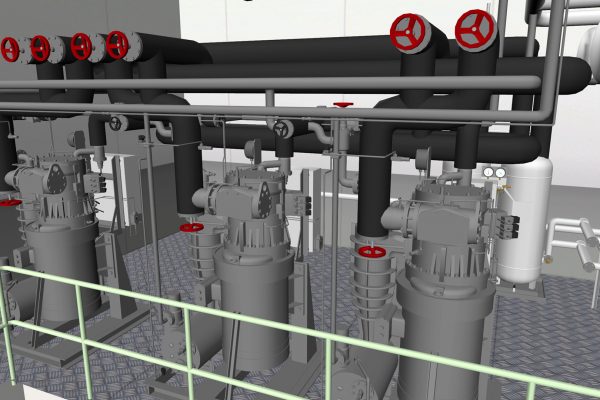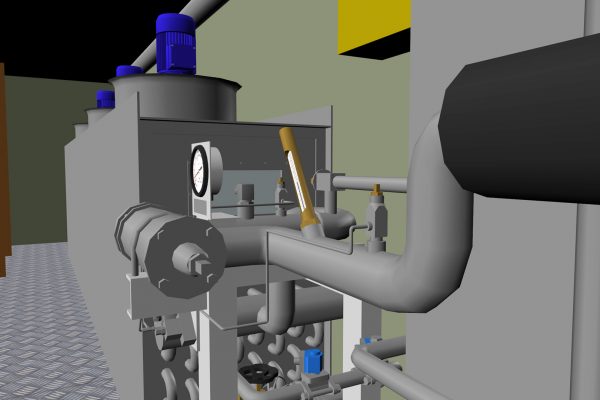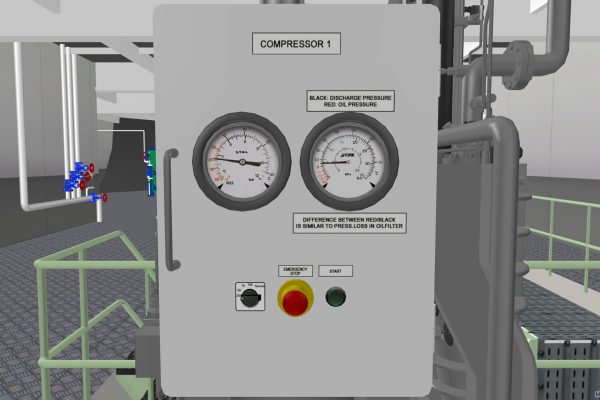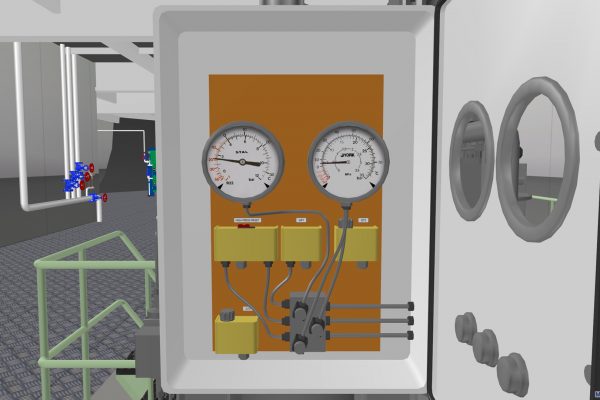Reefer3D Medium Speed Engine Room Reefer Version Simulator
The UNITEST Reefer3D Engine Room Simulator is based on an engine room equipped with medium-sized engine room (four-stroke medium speed engine with reduction gear and controllable pitch propeller). The simulator is a new, extended version of MED3D software and is focused on cargo refrigeration plant.
Refrigeration plants on vessels play a vital part in carrying refrigerated cargo and provisions for the crew on board. In reefer ships, temperature sensitive cargo such as food, chemicals or liquefied gas is controlled in a very precise way.
The simulator is designated for training Marine Engineers, students of maritime academies as well as different types of marine vocational training centres.

Model description
The simulator model is based on a thermodynamic model of vapor compression refrigeration cycle. Cargo refrigeration plant includes the following components:
- three (3) main compressors,
- three (3) condensers,
- three (3) liquid vessels,
- twelve (12) refrigeration chambers,
- control monitoring system.
The main purpose of the simulator is practical preparation of trainees for refrigeration system operation, and more particularly:
- refrigeration plant starting procedure,
- familiarization with typical problems/faults occurring in cargo refrigeration plant,
- familiarization with the engine room installation (electric power plant system, compressed air system, fresh and sea water cooling system, lubricating and fuel oil system, cargo refrigeration system),
- acknowledgment with diesel generators, thrusters and auxiliary equipment starting procedure,
- propulsion system manoeuvring.
To meet the requirements
UNITEST Reefer3D has been developed to comply with STCW Code:
- Section A-1/12 and Section B-1/12,
- ISM Code: Section 6 and Section 8.
Plants overview
All operations in UNITEST Reefer3D simulator can be done in specific system installation and compartments. Each system is presented as a real vessel’s schematic drawings/compartment with ability to control on screen. The most important components of the scheme can be zoomed and sent to a proper location in Engine Room to operate.
UNITEST Reefer3D faults simulation possibilities:
- Iced evaporators,
- Dirty filter before evaporators,
- Evaporators fan damage,
- Dirty floor under the gratings,
- Loading in the sun,
- Rotting of bananas,
- Rapid increase in the temperature of the cargo,
- Air in the condenser,
- Dirty condensers,
- Dirty filter driers,
- Loss of the refrigerant.
UNITEST Reefer3D main features:
- The operator has the possibility to go through a cargo cooling process. The operator can change the condition of the cooling process (actual cooling chamber load, fans speed, number of refrigeration compressors, etc.).
- During the cooling/freezing process, the operator can monitor the number of parameters such as: DAT – delivery air temperature, RAT – return air temperature, overheating of refrigerant, compressor suction and discharge pressure and temperature.
- De-frosting of evaporator can be done with hot freon.
- Daily routines such as check of freon and lube oil levels are simulated.
- Highly realistic simulator for engine room training. All engines and propulsion plant behaviours are based on real respond. To create the impression of working in a real environment, it provides 3D sound which can be listened to on 2, 4 or more speakers.
- The mathematical model simulates an engine room with Medium speed, 4-stroke, reversible, turbocharged and intercooled diesel engine with direct injection of fuel.
- All vital auxiliary systems have been implemented.
- Operations related to drivers’ subsystems including valves operations and all auxiliary equipment (pumps, coolers, filtration units, etc.).
- Learning the engine room’s typical operating routines.
- Engine room operation training. The user will have the possibility to accomplish any operational task starting from different set-ups, both pre-prepared and saved by the user.
- Corrective action learning when faults occur. Different faults can be simulated and mixed in the run-time or loaded from disk.
To meet the requirements:
Engine Room Simulator has been developed to comply with STCW Code:
- Section A-1/12 and Section B-1/12
- ISM Code: Section 6 and Section 8















